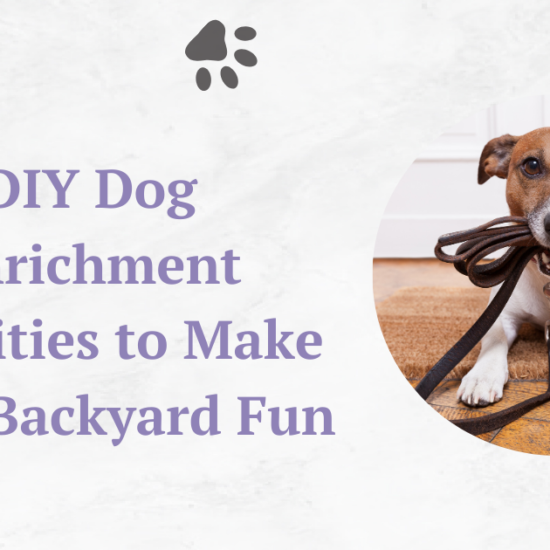Training your dog in basic commands transcends mere obedience; it’s an integral aspect of nurturing a harmonious relationship between you and your furry companion. This comprehensive guide is designed to transform the daunting task of training into an enjoyable and rewarding journey for both you and your pet.
Table of Contents
Introduction
This comprehensive guide is designed to transform the daunting task of training into an enjoyable and rewarding journey for both you and your pet. Whether you’re starting with a lively puppy or an adult dog, these strategies are crafted to lay a robust foundation for behavior management and mutual understanding.
The Essential Role of Basic Commands in Dog Training
The Critical Nature of Basic Commands

Understanding the pivotal role of basic commands in dog training is crucial. These commands are not just instructions; they are the foundational language that bridges the communication gap between humans and dogs. They’re vital in managing behavior, ensuring safety, and fostering a respectful relationship.
Advantages of Training in Basic Commands

- Safety Measures: Commands like “sit,” “stay,” and “come” are lifesavers, literally. They keep your dog safe in potentially dangerous situations.
- Facilitating Social Interactions: Well-trained dogs interact more harmoniously with other pets and people.
- Deepening Bonds: The process of training fortifies the emotional connection between you and your dog, building trust and understanding.
Optimal Training Conditions: Timing and Environment
Choosing the Perfect Moment

The timing of your training sessions is as important as the training itself. It’s best to engage when your dog is alert but calm, avoiding periods of hunger, fatigue, or high distraction.
Creating a Conducive Training Space

Select a quiet, familiar area for training to minimize distractions. A consistent training environment helps your dog focus and learn more efficiently.
Fundamental Commands and Their Significance

“Sit” Command: A fundamental command for controlling impulsive behaviors, like jumping on guests.
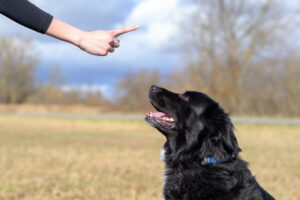
“Stay” Command: Crucial for safety, it teaches your dog to remain stationary until your next cue.
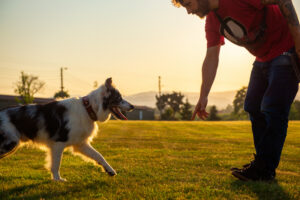
“Come” Command: Vital for recall, especially in off-leash scenarios, ensuring your dog’s responsiveness and safety.
Positive Reinforcement: The Key to Effective Training

The Mechanics of Positive Reinforcement
Using rewards (treats, praise, toys) immediately after your dog follows a command reinforces the behavior. Consistency in rewarding is essential to cement the learning.
Utilizing Treats Effectively
Opt for small, appealing treats and use them judiciously to avoid overfeeding. The treats should be special to maintain your dog’s interest.
Step by Step Guide to Teaching Basic Commands

“Sit”: Use a treat to guide your dog into a sitting position, rewarding them as they comply.
“Stay”: Start with short distances, gradually increasing as your dog masters the command.
“Come”: Practice in a safe, enclosed area, using a leash if necessary, and reward your dog as they respond to the call.
The Importance of Consistency and Patience in Training
Staying Consistent

Use the same commands and signals to avoid confusion. Ensure all family members are aligned in the training approach.
Patience is a Virtue

Remember, each dog learns at its own pace. Stay patient and positive, avoiding frustration during training sessions.
Regular Practice

Consistent, short training sessions are more effective than sporadic, long ones. Keep them engaging and fun.
Note: There might be affiliate links mentioned here. We may receive a commission if you purchase a product through an affiliate link. There is no additional charge for you. Please do your own research before making any online purchases.
Advancing Training and Introducing New Challenges

Once your dog is comfortable with basic commands, gradually introduce new ones to keep them mentally stimulated and engaged.
Troubleshooting Training Challenges
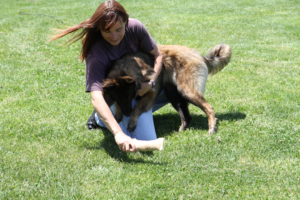
Dealing with Low Motivation: Experiment with different rewards to find what best motivates your dog. Keep sessions lively and short.
Addressing Command-Specific Challenges: If a command isn’t sticking, take a step back and reinforce it in a controlled setting before gradually increasing complexity.
Acknowledging Progress: Celebrate every small victory to motivate both you and your dog.
Integrating Advanced Training Techniques and Tools

As your dog masters basic commands, integrating advanced training techniques and tools can enhance their learning experience and provide additional challenges. This section will explore how to elevate your training regimen.
Advanced Training Techniques
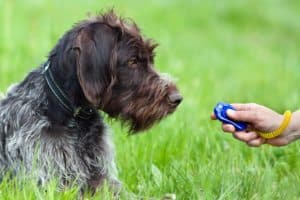
Clicker Training: This method uses a clicker, a small hand-held device that makes a clicking sound. The sound marks the exact moment your dog performs the desired behavior, followed by a reward. It’s a precise way to communicate with your dog and rapidly accelerates learning.

Distance Commands: Start practicing commands from a distance. This teaches your dog to obey even when you’re not close by, which is useful in parks or on hikes.

Adding Distractions: Gradually introduce distractions during training to strengthen your dog’s focus and adherence to commands in various environments.
Utilizing Training Tools

Training Collars and Harnesses: These tools can aid in managing your dog during training, especially for leash manners and recall exercises.

Agility Equipment: Incorporating agility exercises (like tunnels, jumps, and weave poles) not only trains your dog physically but also mentally, enhancing their obedience and agility.
Incorporating Play into Training
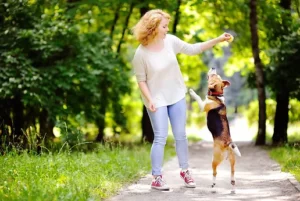
Play-Based Training: Integrating play into your training sessions keeps your dog engaged and makes learning fun. Use fetch or tug-of-war as rewards for successful command execution.

Teaching Tricks and Games: Beyond practical commands, teaching tricks like ‘roll over’ or ‘play dead’ adds variety and mental stimulation to your dog’s routine.
Social and Environmental Exposure

Socializing with Other Dogs: Regular interaction with other dogs improves social skills and can reinforce training in a multi-dog environment.

Exposing to Different Environments: Train in various locations to help your dog generalize commands outside the comfort of their usual training space.
Conclusion
Embarking on the journey of teaching your dog basic commands is a fulfilling experience that strengthens your bond and ensures a well-mannered, safe companion. This guide provides a roadmap to navigate this journey, emphasizing the importance of understanding, patience, and consistent practice. Through this process, you’ll cultivate a deep, respectful, and loving relationship with your canine friend.
Expanding your training regimen with advanced techniques and tools not only keeps your dog mentally stimulated and physically active but also strengthens your bond through diverse and enjoyable learning experiences. Remember, the goal of advanced training is not just to teach new skills but to deepen the trust and understanding between you and your dog.



